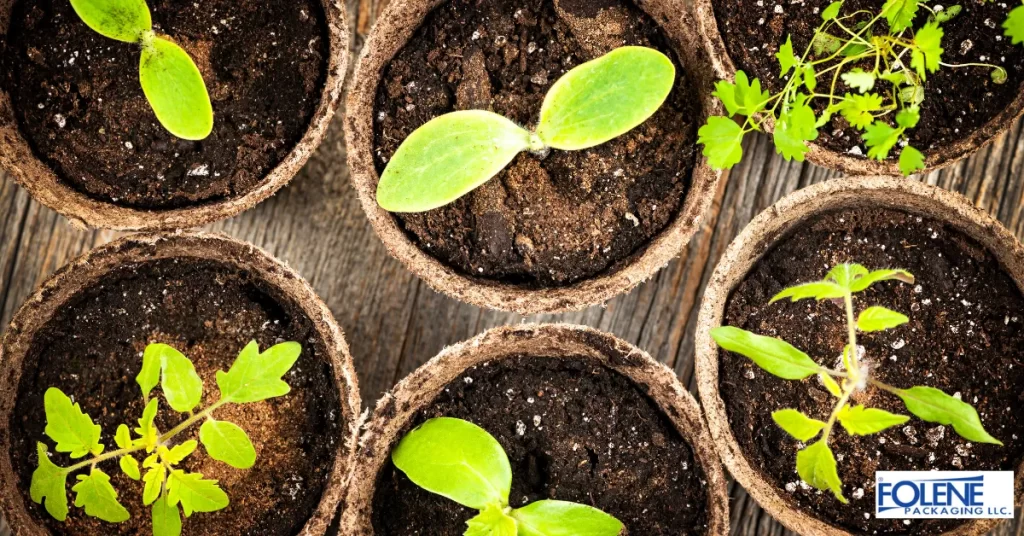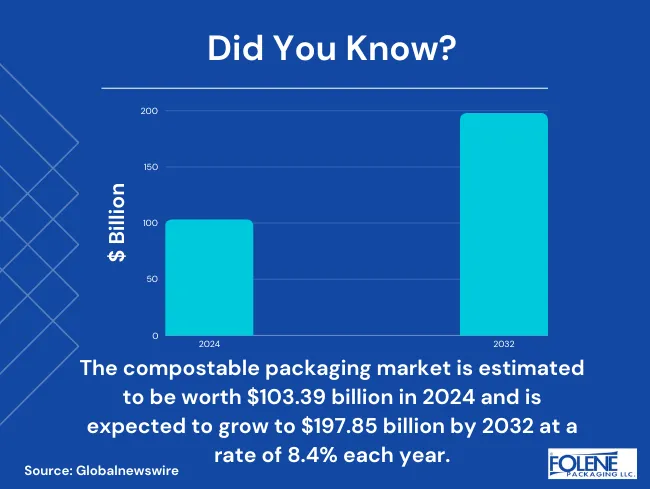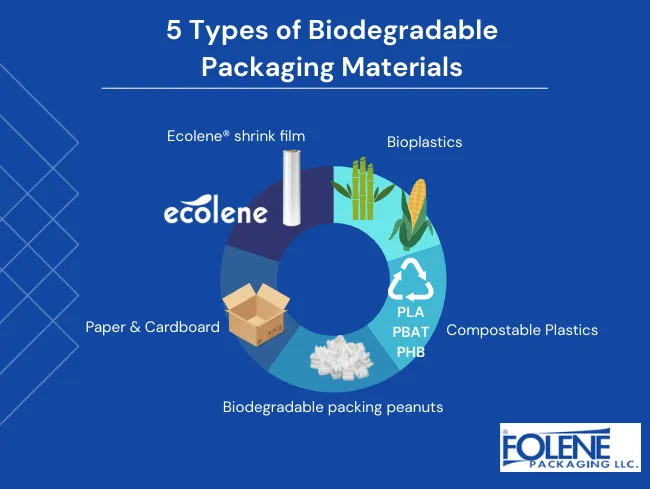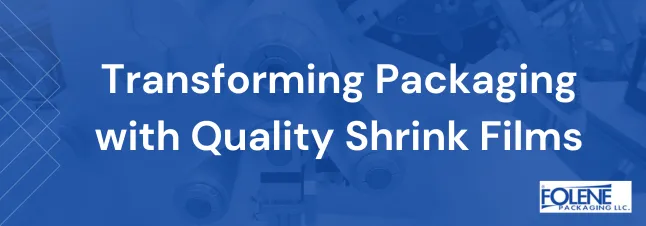
Is recycling really the best way to reduce plastic waste? Less than 10% of all petroleum-based plastics are recycled globally. Using biodegradable packaging is a much faster route to eliminating plastic packaging waste.
Despite the goodwill to make a difference and reduce their carbon footprint, manufacturers and retailers face difficulties dealing with waste management systems and recycling. Manufacturers have lost products, productivity, and profits to weak and unstable packaging. In addition, manufacturers and retailers have found that waste often requires special treatment—an unwanted added expense. They want biodegradable packaging of a better grade and a more manageable, streamlined way to dispose of plastic packaging waste. Biodegradable packaging is emerging as a more viable solution.
What does ‘biodegradable’ mean?
Biodegradable packaging is protective wrapper material made from materials that microorganisms can ‘digest.’ ‘Biodegradable’ means something that can be broken down into its constituent components. It will disintegrate naturally and decompose with the help of bio-friendly organisms. For example, researchers at UT Austin worked with bacteria, fungi, and algae and settled on an enzyme that can break down biodegradable products into smaller, non-plastic, bio-friendly monomers.

Is the Meaning of Biodegrade Clear?
The meaning of biodegrade is vague in this context. Some biodegradable packaging materials will break down entirely but leave a residue of tiny plastic particles. Biodegradable wrappings can be made from plant-based materials, including corn starch or hemp, which is 100% biodegradable in the natural elements.
What does it mean for the environment? It represents hope for a sustainable future, avoiding the use of fossil fuels for packaging and much less plastic packaging material that clogs up waste systems.
Why is Biodegradable Packaging Important?
Due to its 100% decomposition, biodegradable packaging ensures less overall waste to manage. Using biodegradable packaging helps reduce the amount of waste in the food industry, among other sectors, and results in waste taking up less landfill space.
Experts in biodegradable materials note that how well the materials decompose or biodegrade is more important than what they are made from. The best combinations of biodegradable packaging and biodegradation will biodegrade the materials in several weeks, leaving nutrient-rich soil, humus, and biomass, contributing to the ‘circular economy.’
As manufacturers note consumer purchasing power, more and more manufacturers are responding with more biodegradable packaging.
Is There Evidence That Biodegradable Packaging is Increasing in Demand?
FMI forecasts that the increasing demand for sustainable and biodegradable packaging will create a growth opportunity of $1.8 billion in the United States. Also, as of January 2023, 81% of consumers were demanding sustainable packaging in a continued move to eliminate plastic waste.

Biodegrade vs. Sustainable: Is All Biodegradable Packaging Sustainable Packaging?
It depends on what the product is made of and how well it contributes to the circular economy. Technically, many packaging materials are biodegradable, but they will only break down over many years. The harmful emissions they create as they do so are also not good for the environment.
Certified biodegradable packaging is sustainable if it breaks down in a reasonable amount of time. This is usually up to 90 days in industrial composting conditions and 180 days in home composting conditions. Only truly sustainable packaging reduces environmental impact and promotes eco-friendliness.
4 Environmental Advantages of Biodegradable Packaging
For the environment, the benefits of biodegradable plastic and sustainable plastic packaging include:
Biodegradable packaging reduces plastic waste and pollution in landfills and oceans.
Biodegradable materials, made from sustainable sources, conserve natural resources using renewable materials.
Biodegradation (especially by composting) mitigates climate change by reducing greenhouse gas emissions.
Natural regeneration through breaking down biodegradable packaging helps to create a circular economy and promotes recycling and composting.
5 Types of Biodegradable Packaging Materials
Here are just a few of the end-products and biodegradable packaging materials available today. Professional packaging experts can advise you on the best type of sustainable packaging options for your packaging needs:
Bioplastics: Non-toxic, practical, eco-friendly, and suitable for food packaging. Sustainable plastic packaging is made from plant-based materials like cornstarch, sugarcane, and potato starch.
Paper and cardboard: Packaging made from recycled paper products.
Compostable plastics: Some examples are PLA (a plant-based renewable resource that must be heated in an industrial composting facility), PBAT (made from organic materials, a non-renewable fossil resource), and PHB (bio-derived and biodegradable plastic).
Biodegradable packing peanuts: A water-soluble alternative to newly-created polystyrene (Styrofoam) that cannot clog up rivers (a renewable resource made from natural materials like starch and wheat straw).
Ecolene® environmentally-friendly shrink film: Upon disposal, the film biodegrades under almost any disposal condition without special treatment.

Top 8 Biodegradable Packaging Sources
Looking at some of the naturally biodegradable packaging materials and discovering more about eco-friendly packaging materials shows that we have made unbelievable progress in developing a circular economy. We are using more raw materials that are abundant, easy to grow or collect, and decompose quickly.
Mushroom-based packaging
Mushroom-based packaging looks very similar to standard cardboard packaging. The raw material is made from agricultural waste and mycelium, such as mushroom roots and hemp.
Seaweed-based packaging
Seaweed-based packaging uses agar and other seaweed extracts. Seaweed for seaweed packaging can be cultivated and harvested quickly, and its impact on the environment is mainly good. Seaweed draws carbon dioxide from the atmosphere, thereby reducing global warming.
Cornstarch-based packaging
Cornstarch-based packaging is known as a zero-waste material. Production of cornstarch is energy efficient, with little greenhouse gas emissions. It is one of the most common bio-based materials, made only from biodegradable and compostable materials.
Paper-based packaging
Biodegradable packaging can be made from post-consumer recycled plastic, paper, and cardboard and avoids using newly-created (‘virgin’) source materials. Read about levels of biodegradability in the IDTechEx report 2020-2025

Edible packaging
Edible packaging is still a very new concept. Some prototypes use natural ingredients like fruit pulp and algae. This is certainly a packaging trend to follow, but there is not yet enough data to conclude if it is a practical or cost-effective form of packaging.
Plantable packaging
Plantable packaging is wholly regenerative and made from seeds and biodegradable materials. The substance is compostable packaging, which contains seeds. The packaging disintegrates once buried in natural soil, and flowers or herbs will grow from the planted seeds.
Inflatable air pillows
Inflatable air pillows made from biodegradable materials like cornstarch and potato starch protect items during delivery and effectively reduce damaged returns due to product packaging being of a high standard. The pillows are usually made from recycled materials and are compostable.
Ecolene® biodegradable polyolefin shrink film
Polyolefin eco-friendly shrink films are a clear and cost-effective packaging material choice for manufacturers. Folene Packaging’s innovative Ecolene® brand has the same strength, optics, and performance as non-biodegradable polyolefin shrink film while maintaining complete biodegradation abilities. Ecolene® biodegradable film, unlike other materials, does not begin to degrade until disposal.
How Ecolene® Biodegradable Polyolefin Shrink Film Helps Manufacturers and Retailers Embrace Biodegradable Packaging
Ecolene® offers a unique environmentally-friendly packaging solution that shrink-wraps your products effectively and hygienically while maintaining the same powerful packaging strength and optics as our more conventional packaging materials. Our non-biodegradable range of polyolefin shrink films is fully recyclable as well. For your ultimate convenience, Folene Packaging offers the full range of biodegradable, compostable shrink-wrap in the exact sizes, gauges, and roll lengths as our standard polyolefin shrink films.
Since the future of packaging lies in sustainable and biodegradable solutions, Folene Packaging is here to help you manufacture with peace of mind as you reduce the environmental impact of manufacturing by selecting biodegradable packaging materials.
As a knock-on effect for your clients, retailers will be delighted to promote sustainable packaging by dealing with manufacturers and products that use eco-friendly packaging.
Reach out to work together toward a sustainable future with Ecolene® biodegradable packaging, presented with pride by Folene Packaging.



